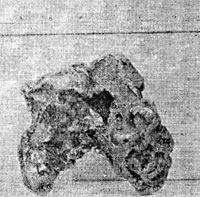| Home | AmMin | GMR | RiMG | Collectors Corner | Directory | Short Courses | |
|
|
|||||||

|
|
Volume 16, pages 267-269, 1931 AN ARIZONA GOLD NUGGET OF UNUSUAL SIZE1 ROBERT E. S. HEINEMAN, University of Arizona. Recently a gold nugget of a size sufficient to be worthy of description was brought into the office of the Arizona Bureau of Mines. The owner of the nugget, Mr. John B. Ehrhart, stated that it was found about the middle of November, 1930, in a placer in the Weaver district, Arizona. The exact location, according to Mr. Ehrhart, was about a mile from Octave, on the property controlled by the Red Bank Gold Placer Company. The Weaver district and the Octave postoffice are in southern Yavapai County about seven or eight miles east of Congress Junction. The district has been described by Wilson2 who says, "The Weaver Mountains, which are made up mainly of pre-Cambrian granites and schists, overlain by Tertiary lavas, contain numerous gold-bearing quartz veins that were the source of these placers. "Broadly speaking, the placer ground covers an area of approximately 8 by 5 miles. It is said that the most productive portions, which were in the northern half of this area, included about 10 acres on the north-eastward-sloping top of Rich Hill; certain portions of the sides of the hill; the channels and benches of Weaver, Antelope, and other washes; and the gravel mesas that lie between these washes. On the top of Rich Hill the gold occurs on bedrock that in places is covered with boulders and a thin layer of residual clay. Along the washes below, and in the mesas, however, the placer material consists of iron-stained gravel and sand, up to 10 or more feet thick, together with abundant, subangular boulders that are 2 to 6 feet in diameter." The Rich Hill channel is noted for its heavy gold. Blake says3 that nuggets were found which were worth approximately $450, $400, $300, and $150. Three other lumps were worth $1008 in the aggregate. Hardly any fine gold was found. The nugget described in this paper, while not the largest discovered, belongs in the group of those of major proportions. The story of the discovery of these placers is rather interesting. Again quoting Wilson,4 "In the early sixties, certain Indians who came to La Paz, near the Colorado River, to trade, reported the occurrence of much gold many miles farther east. One of them was persuaded to guide a party, consisting of Capt. Pauline Weaver, Maj. A. H. Peeples, and others, to the locality. This party happened to camp at the base of Rich Hill, after their guide had deserted them on the desert north of Wickenburg. A Mexican of the party, while looking for their strayed animals, discovered loose nuggets on the top of Rich Hill. This discovery led ... to the finding of the placers on Weaver and Antelope creeks. "This whole area became the scene of intense activity, and in 5 years, according to Hall,5 produced about $500,000 ... and the production of the whole area, prior to 1883, was estimated by Hamilton6 at $1,000,000 .... Production from 1905 to 1924, inclusive, amounted to about $75,500 ...."
Mr. Ehrhart's nugget is in general outline shaped somewhat like a human molar. (Fig. 1). It measures approximately 53 mm. across the widest portion of the "roots," and 47 mm. from the bottom of the "root" to the "crown." Several fragments of slightly iron-stained quartz remain in the center of the mass. The surface is well worn on the exposed portions but where protected is rather rough. The total weight is 270.90 grams. The weight in water was found to be 250.32 grams. Heikes states7 that all of the gold from the Weaver placers has a fineness of 910. Assuming that the gold in this nugget also has a fineness of 910 several calculations were made. The nugget was not available for assay purposes. The specific gravity of gold of 910 fineness is 18.53. Using this figure it may be calculated that the nugget consisted of 252.38 grams of metal and 18.52 grams of quartz. 252.38 grams of gold of a fineness of 910 is equivalent to 229.67 grams of pure gold which is worth $152.62 and 22.71 grams of silver which is worth about 21 cents at the date of writing. (Note: Since this article was written, the nugget has been procured by Dean G. M. Butler of the University of Arizona.) NOTES 1 Published by permission of the Director, Arizona Bureau of Mines. 2 Wilson, E. D., Arizona gold placers, Univ. Ariz., Ariz. Bur. Mines, Bull. 124, 26-28,1927. 3 Blake, W. P., Rep't of the Territorial Geologist, in Rep't of the Governor of Arizona, 66, 1899. 4 Wilson, E. D., op. cit. 5 Hall, Sharlot, former State Historian, personal communication. 6 Hamilton, Patrick, Resources of Arizona, 1883. 7 Heikes, V. C., U. S. Geol. Survey, Min. Res., I, 259, 1912.
|
